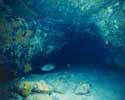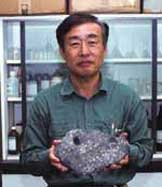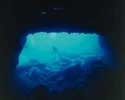|
The image below is of the face of the structure referred to by Professor Masaaki Kimura’s Research Group in Japanese as ‘Tategami-iwa’. This ‘Moai-like figure’ is very impressive and was discovered underwater off the northeast coast of Yonaguni-jima. And there is another example of a similar ‘Tagegami-iwa’ figure found on the coast of Yonaguni-jima island itself.
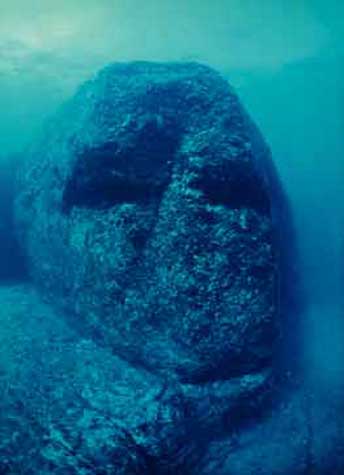
–
Okinawa, Japan
–
The image on the left below is of the coastal ‘Tategami-iwa’ figure as seen from the sea, where its eroded features show what appears to be the outline of a ‘human face’, though Professor Kimura and his team believe this outline has developed ‘naturally’. The image on the right below is of the ‘Tategami-iwa’ figure as it is seen from the coast.
The flat foundation base is symmetrically cut and is definitely ‘artificial’. It may have been used as a ‘sacred’ religious symbol at some time in the far distant past. Such a prominent outcrop of rock may well have been highly revered by the local peoples as an important ‘sacred rock’ for many thousands of years before the flat foundation base had been ‘artificially enhanced’.
There are many examples throughout the world where natural outcrops have been ‘terra-formed’ in this manner, and the Great Sphinx at Giza is probably a much later example of this widespread ancient practice.
|
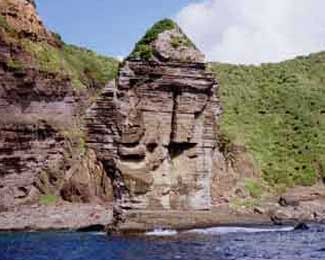
—
Okinawa, Japan
—
|
|
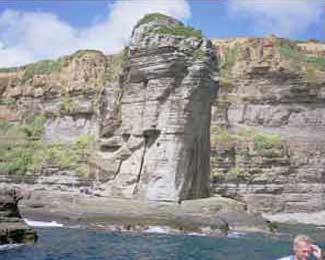
—
Okinawa, Japan
—
|
The eyes of the ‘Moai-like’ figure, known in Japanese as ‘Tategami-iwa’, show signs of being ‘artificially enhanced’. In this close-up image of the pupils it is possible to see a good example of how ‘nature’ can initially suggest a shape, which human hands then seem to have ‘modified’, making what was essentially a crude stone face very similar to those that can be found in many locations around the mysterious Easter Island far away in the Pacific, into something with local cultural significance.
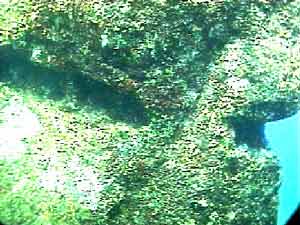
—
Okinawa, Japan
—
History’s Mysteries
“Do undersea relics near Okinawa offer proof of a sophisticated civilization during the last ice age?
Archeologists have long believed that civilization as they define it — intelligent, tool-making, monument building, social humans — began about 5,000 years ago.
But submerged beneath the waves near the Japanese island of Yonaguni is evidence that may well overturn that long-held theory.
A small but persuasive number of scholars and scientists have long thought that “advanced” societies may have existed as long as 10,000 years ago.
Their theories, however well reasoned and defended, have been hamstrung by a lack of evidence..
But recent discoveries of man-made artifacts on the Pacific seafloor may well prove to be the smoking gun that will propel this alternative view of civilization to prominence”.
see the evidence with ‘unique underwater footage’
of the various Yonaguni structures in the
‘History Channel’ TV programme
“Japan’s Mysterious Pyramids”
NTSC DVD
or
VHS
|
|
Books About
Prehistoric Japan
“Ancient Jomon of Japan”
by
 Junko Habu Junko Habu

Get This Book From:
Amazon.com
Amazon.co.uk
“Prehistoric Japan:
New Perspectives on Insular East Asia”
by
 Keiji Imamura Keiji Imamura

Get This Book From:
Amazon.com
Amazon.co.uk
“In the Wake of Jomon: Stone Age Mariners and a Voyage Across
the Pacific”
by
 Jon Turk Jon Turk

Get This Book From:
Amazon.com
Amazon.co.uk
“An Archaeological History of Japan, 30,000 B.P. to A.D. 700”
by
 Koji Mizoguchi Koji Mizoguchi

Get This Book From:
Amazon.com
Amazon.co.uk
“Sacred Texts and Buried Treasure:
Issues on the Historical Archaeology of Ancient Japan”
by
 William Wayne Farris William Wayne Farris

Get This Book From:
Amazon.com
Amazon.co.uk
“Shinto:
The Sacred Art of Ancient Japan”
by
 Victor Harris Victor Harris
(Editor)
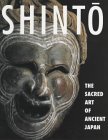
Get This Book From:
Amazon.com
Amazon.co.uk
|

